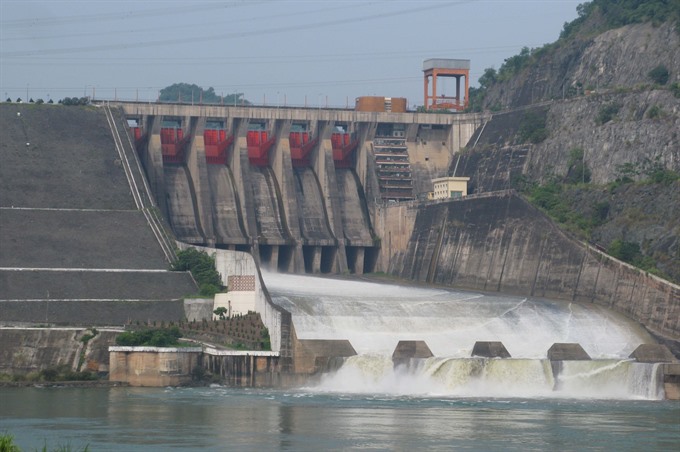 Environment
Environment

With hydroelectricity supplying nearly 40 per cent of Viet Nam’s generated power, the country’s energy security depends on quality reservoir planning and management, according to experts.
 |
| Hòa Bình Hydropower Plant discharges water in July this year. — VNA/VNS Photo |
HÒA BÌNH — With hydroelectricity supplying nearly 40 per cent of Việt Nam’s generated power, the country’s energy security depends on quality reservoir planning and management, according to experts.
Participants at a workshop on sustainable energy development in the northern province of Hòa Bình on Thursday made it clear how much Việt Nam relies on hydroelectricity.
According to the Ministry of Agriculture and Rural Development, as of 2016, Việt Nam had nearly 7,000 reservoirs including irrigation reservoirs and hydropower reservoirs. About 1,200 reservoirs are dilapidated and need repairs, as most of them were built a long time ago.
Among those 7,000 reservoirs, more than 230 are hydropower reservoirs which generate nearly 90 per cent of total capacity of all reservoirs in the country.
“Nearly 7,000 reservoirs is a massive property of the nation. With the capacity of each hydropower reservoir reaching up to hundreds to billions of cubic metres of water, lowland areas will suffer severely if any reservoir breakdown occurs,” said Đào Trọng Tứ, deputy director of Centre for Sustainable Development of Water Resources and Adaptation to Climate Change (CEWAREC).
According to CEWAREC experts, hydropower reservoir incidents were caused mostly due to outdated technical standards, low-quality construction and ineffective operation.
“In the context of unforeseeable weather conditions which have occurred recently with higher frequency, reservoir operation procedures need to be adapted. The reservoir operation guidelines designed based on data collected in the past are only a source of reference.
“The operation regulations are not always the guidelines for all scenarios. When floods occur, operators need to be flexible in directing water release depending on each condition and scenario. The forecast and early alerts need to be issued so that lowland areas can actively respond to the release and minimise losses,” Tứ said.
In September this year, the Government issued Decree 114 to direct management agencies to safely operate dams and reservoirs. It clarifies the responsibilities of relevant sectors, including the ministries of agriculture and rural development; natural resources and environment; and planning and investment.
Lê Thế Phong, a specialist of the production planning division of Việt Nam Electricity (EVN), said the difference between Decree 114 and previous legal documents on reservoir safety is that it stipulates safety not only for dams but for whole lowland areas as well, because when the lowlands are safe, the reservoirs avoid risks as well.
To improve forecasting capacity, the EVN will call for the involvement of private investors in building rainfall-measuring stations to better operate the reservoirs, he said.
According to Đặng Ngọc Vinh, CEWAREC director, many countries have chosen no to build new hydropower plants.
“Việt Nam has fully developed hydropower with 85 per cent of water source’s economic and technical potentials being exploited. Hydropower has had serious impacts on the environment and the rivers are on the verge of getting damaged if hydropower development continues,” he said.
Using global experience, Việt Nam needs to seek alternative sources of energy, he said.
According to the Government’s electricity planning, hydropower output proportion, which accounted for nearly 40 per cent of the country’s production in 2015, will be scaled down to about 17 per cent by 2030, meanwhile, renewable energy will make up 21 per cent of the country’s total power output in 2030 instead of 5.7 per cent in 2015.
Developing renewable energy is a solution for Việt Nam to balance the domestic and imported energy sources as Việt Nam is predicted to have to import two-thirds of its energy by 2030, which might pose risks to the country’s energy security, Ngụy Thị Khanh, director of Việt Nam’s Green Innovation and Development Centre said. — VNS




